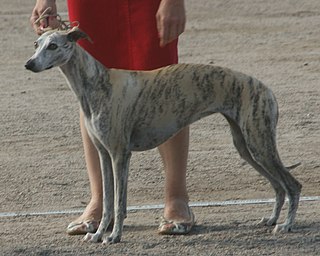
The whippet is a British breed of medium-sized dog, of the sighthound type, related to the larger greyhound and the smaller Italian greyhound. Apart from the differences in height, the whippet closely resembles these two breeds; it has sometimes been described as "the poor man's greyhound". It is kept as a companion dog, for competitive showing, for amateur racing as well as lure coursing. It has the highest running-speed of any breed in its weight and size range, and may have the fastest idle-to-running acceleration of any dog.

A dog breed is a particular type of dog that was purposefully bred by humans to perform specific tasks, such as herding, hunting, and guarding. Dogs are the most variable mammal on Earth, with artificial selection producing upward of 360 globally recognized breeds. These breeds possess distinct traits related to morphology, which include body size, skull shape, tail phenotype, fur type, body shape, and coat colour. However, there is only one species of dog. Their behavioral traits include guarding, herding, and hunting, and personality traits such as hyper-social behavior, boldness, and aggression. Most breeds were derived from small numbers of founders within the last 200 years. As a result of their adaptability to many environments and breedability for human needs, today dogs are the most abundant carnivore species and are dispersed around the world.

The American Kennel Club (AKC) is a registry of purebred dog pedigrees in the United States. In addition to maintaining its pedigree registry, this kennel club also promotes and sanctions events for purebred dogs, including the Westminster Kennel Club Dog Show, an annual event which predates the official forming of the AKC, the National Dog Show and the AKC National Championship. The AKC is a non-member partner with the Fédération Cynologique Internationale. The AKC recognizes 200 dog breeds, as of 2022.
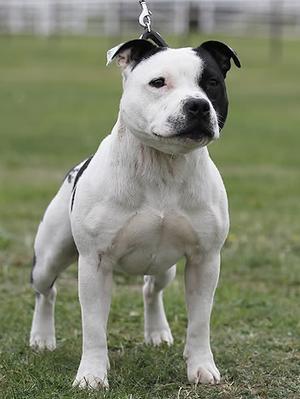
The Staffordshire Bull Terrier, also called the Staffy or Stafford, is a purebred dog of small to medium size in the terrier group that originated in the northern parts of Birmingham and in the Black Country of Staffordshire, for which it is named. They descended from 19th-century bull terriers that were developed by crossing bulldogs with various terriers to create a generic type of dog generally known as bull and terriers. Staffords share the same ancestry with the modern Bull Terrier, although the two breeds developed along independent lines, and do not resemble each other. Modern Staffords more closely resemble the old type of bull terrier, and were first recognised as a purebred dog breed by The Kennel Club of Great Britain in 1935.
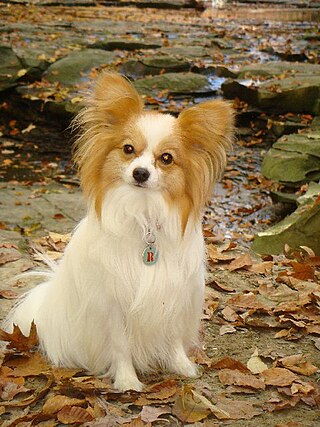
The Papillon, also called the Continental Toy Spaniel, is a breed of dog, of the spaniel type. One of the oldest of the toy spaniels, it derives its name from its characteristic butterfly-like look of the long and fringed hair on the ears. A Papillon with dropped ears is called a Phalene.

The Fédération Cynologique Internationale is the largest international federation of national kennel clubs and purebred registries. The FCI is based in Thuin, Belgium and has 98 members and contract partners.
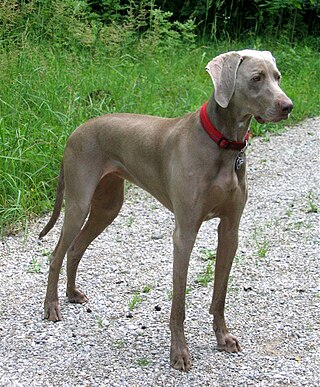
The Weimaraner is a German breed of hunting dog of medium to large size, with history going back at least to the nineteenth century.

Crufts is an international dog show held annually in the United Kingdom, held since 1891, and organised by The Kennel Club. It is the largest show of its kind in the world.

The Japanese Terrier is a small terrier native to Japan. It is believed to be descended from the progeny of fox terrier types, pointers and indigenous Japanese dogs.

A kennel club is an organization for canine affairs that concerns itself with the breeding, showing and promotion of more than one breed of dog. Kennel clubs became popular in the mid 19th century. All-encompassing kennel clubs are also referred to as 'all-breed clubs', although "all" means only those breeds that they have decided to recognize, and "breed" means purebred dogs, not including dog hybrids and crossbreeds or mixed-breed dogs. A club that handles only one breed is known as a breed club.

The Westminster Kennel Club Dog Show is an all-breed conformation show, held annually in the New York metropolitan area.
A breed registry, also known as a herdbook, studbook or register, in animal husbandry, the hobby of animal fancy, is an official list of animals within a specific breed whose parents are known. Animals are usually registered by their breeders while they are young. The terms studbook and register are also used to refer to lists of male animals "standing at stud", that is, those animals actively breeding, as opposed to every known specimen of that breed. Such registries usually issue certificates for each recorded animal, called a pedigree, pedigreed animal documentation, or most commonly, an animal's "papers". Registration papers may consist of a simple certificate or a listing of ancestors in the animal's background, sometimes with a chart showing the lineage.

The Japan Kennel Club (ジャパンケネルクラブ) is the primary registry body for purebred dog pedigrees in Japan.

Championships are awarded to dogs who have passed through a process of selection at dog shows. Traditionally, a championship was received at a conformation show, but championships are now offered for dogs who have attained a high degree of perfection in other dog sports as well.
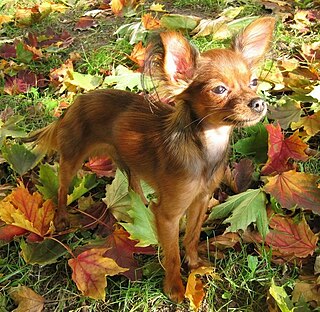
The Russian Toy is a very small breed of dog originally bred in Russia from the English Toy Terrier. There are two types of coats in the breed: smooth coat and long coat. The smooth-coated variety was previously known as the Russian Toy Terrier and long-coated as the Moscow Long-Haired Toy Terrier. Both were brought together under the same Russian Toy Terrier name in 1988 and the "Terrier" was dropped from the name when the breed was added in 2006 to the official list of breeds registered with the Fédération Cynologique Internationale. The breed has been registered in the Foundation Stock Service of the American Kennel Club (AKC) since 2008, and has been allowed to compete in AKC companion events since 2010. The first official breed standard of the two varieties was written in 1966 in Russia.

The Société centrale canine, officially the Société Centrale Canine pour l'Amélioration des Races de Chiens en France and abbreviated SCC, is a French kennel club founded in 1881. It is made up of regional clubs and breed clubs, and coordinates and regulates activities and connections between governmental groups and dog clubs, as well as activities through the Fédération cynologique internationale, where it was one of the original five founding member organizations in 1911.
The Kennel Club of India is a registry of purebred dogs in India. As well as maintaining a registry of pedigrees, the club promotes and sanctions events for purebred dogs, including annual dog shows and specialty shows. The Kennel Club of India is a member of the Fédération Cynologique Internationale.
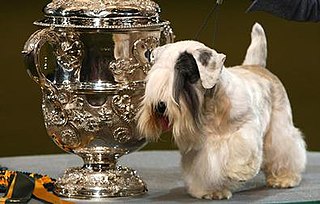
Ch. Efbe's Hidalgo At Goodspice, also known as Charmin, was a male Sealyham Terrier who was the Best in Show at the American Kennel Club National Championship in 2007, World Dog Show in 2008, and Crufts in 2009. He also won the Terrier Group at the Westminster Kennel Club dog show in 2008.
Ch. Fiacre's First and Foremost, also known as Fiona, is a Dalmatian bred to have low levels of uric acid. She is registered to the United Kennel Club Dalmatian Breed Club in America and was registered with the American Kennel Club in 2011, when LUA Dalmatians were granted entry into the AKC. She became the first low uric acid Dalmatian to compete at Crufts in the United Kingdom in 2011.

The Miniature American Shepherd, frequently abbreviated MAS, is a small herding dog breed. The MAS is highly intelligent and biddable. The breed is often trained for dog sports such as herding, agility, obedience, canine freestyle, flyball, and others. The Miniature American Shepherd was recognised by the American Kennel Club (AKC) in 2015 and is the club's 186th breed. In September 2019, the Fédération Cynologique Internationale (FCI) officially accepted the breed.



























